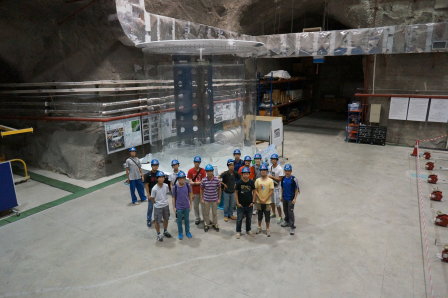Media
Hide & Seek: Sterile Neutrinos Remain Elusive
Daya Bay neutrino experiment publishes a new result on its first search for a “sterile” neutrino
03 Oct 2014
BEIJING; BERKELEY, CA; and UPTON, NY—The Daya Bay Collaboration, an international group of scientists studying the subtle transformations of subatomic particles called neutrinos, is publishing its first results on the search for a so-called sterile neutrino, a possible new type of neutrino beyond the three known neutrino “flavors,” or types. The existence of this elusive particle, if proven, would have a profound impact on our understanding of the universe, and could impact the design of future neutrino experiments. The new results, appearing in the journal Physical Review Letters, show no evidence for sterile neutrinos in a previously unexplored mass range.
There is strong theoretical motivation for sterile neutrinos. Unlike the three known types –electron, muon and tau neutrinos, it does not have the conventional weak interaction. Interacting only through gravity, the sterile neutrino is a popular candidate of dark matter – the dominant form of matter in the universe. Yet, the experimental landscape is unsettled—several experiments have hinted that sterile neutrinos may exist, but the others yielded null results. Having amassed one of the largest samples of neutrinos in the world, the Daya Bay Experiment is poised to shed light on the existence of sterile neutrinos.
The Daya Bay Experiment is situated close to the Daya Bay and Ling Ao nuclear power plants in China, 55 kilometers northeast of Hong Kong. These reactors produce a steady flux of antineutrinos that the Daya Bay Collaboration scientists use for research at detectors located at varying distances from the reactors. The collaboration now has more than 200 scientists from six regions and countries including The University of Hong Kong and The Chinese University of Hong Kong.
“The Daya Bay experiment began its operation on December 24, 2011. Soon after, in March 2012, the collaboration announced its first results: the observation of a new type of neutrino oscillation—evidence that these particles mix and change flavors from one type to others—and a precise determination of a neutrino “mixing angle,” called θ13, which is a definitive measure of the mixing of at least three mass states of neutrinos” says Dr. John K.C. Leung, one of the collaborators from The University of Hong Kong.
“These observations have led to the possibility that the electrically neutral, almost undetectable sterile neutrino could be a special type of matter and a very important component of the mass of the universe” says Dr. Jason C.S. Pun, another collaborator from The University of Hong Kong.
The new Daya Bay paper describes the search for sterile neutrinos by looking for the disappearance of electron antineutrinos produced from the reactors. If, like the known flavors, the sterile neutrino also exists as a mixture of different masses, it would lead to mixing of neutrinos from known flavors to the sterile flavor, thus giving scientists proof of its existence. That proof would show up as a disappearance of neutrinos of known flavors.
Within the searched mass range for a fourth possible mass state, Daya Bay found no evidence for the existence of a sterile neutrino.
This data represents the best world limit on sterile neutrinos over a wide range of masses and so far supports the standard three-flavor neutrino picture. Given the importance of clarifying the existence of the sterile neutrino, there are continuous quests by many scientists and experiments. The Daya Bay’s new result remarkably narrowed down the unexplored area.
Fig. 1: Students and researchers from CUHK and HKU at the underground Daya Bay Far Experimental Hall. A full size model of an anti-neutrino detector is shown at the background.
About the team
The collaborating institutions of the Daya Bay Reactor Neutrino Experiment are Beijing Normal University, the U.S. Department of Energy’s (DOE) Brookhaven National Laboratory, California Institute of Technology, Charles University in Prague, Chengdu University of Technology, China General Nuclear Power Group, China Institute of Atomic Energy, Chinese University of Hong Kong, Dongguan University of Technology, East China University of Science and Technology, Joint Institute for Nuclear Research, University of Hong Kong, Institute of High Energy Physics, Illinois Institute of Technology, Iowa State University, DOE’s Lawrence Berkeley National Laboratory, Nanjing University, Nankai University, National Chiao-Tung University, National Taiwan University, National United University, National University of Defense Technology, North China Electric Power University, Princeton University, Pontifical Catholic University of Chile, Rensselaer Polytechnic Institute, Shandong University, Shanghai Jiao Tong University, Shenzhen University, Siena College, Temple University, Tsinghua University, University of California at Berkeley, University of Cincinnati, University of Houston, , University of Illinois at Urbana-Champaign, University of Science and Technology of China, Virginia Polytechnic Institute and State University, University of Wisconsin-Madison, College of William and Mary, Xi’an Jiao Tong University, Yale University, and Sun Yat-Sen (Zhongshan) University.
A complete list of funding agencies for the experiment can be found in the published paper.
For more information, visit http://dayabay.ihep.ac.cn/
For press enquiry, please contact Ms Cindy Chan, Senior Communication Manager of Faculty of Science, at 3917-5286/ 6703- 0212 or by email at cindycst@hku.hk; or members of the Collaboration from HKU Department of Physics Dr John K C Leung at tel: 2859-2858/ email: jkcleung@hku.hk or Dr Jason C S Pun at tel: 2859-1962/ jcspun@hku.hk

